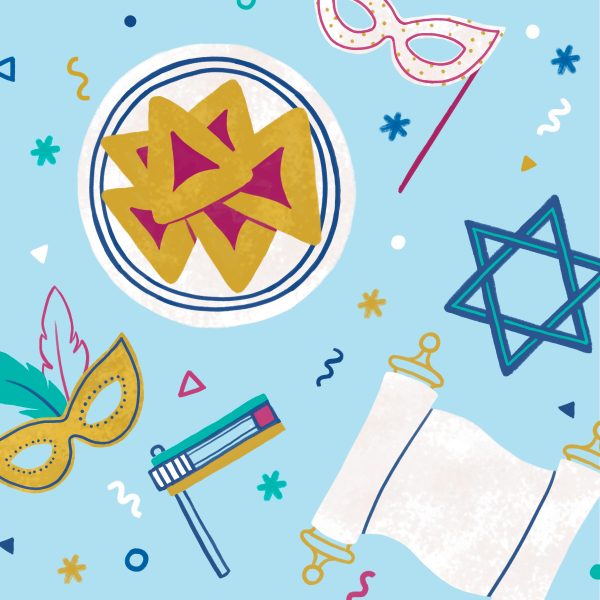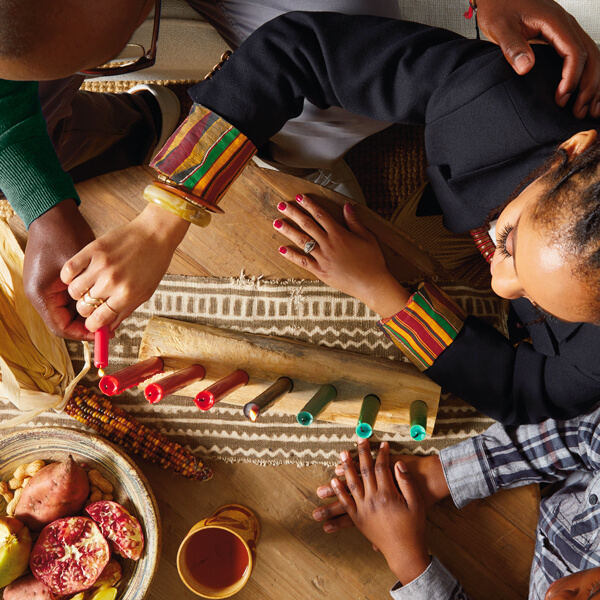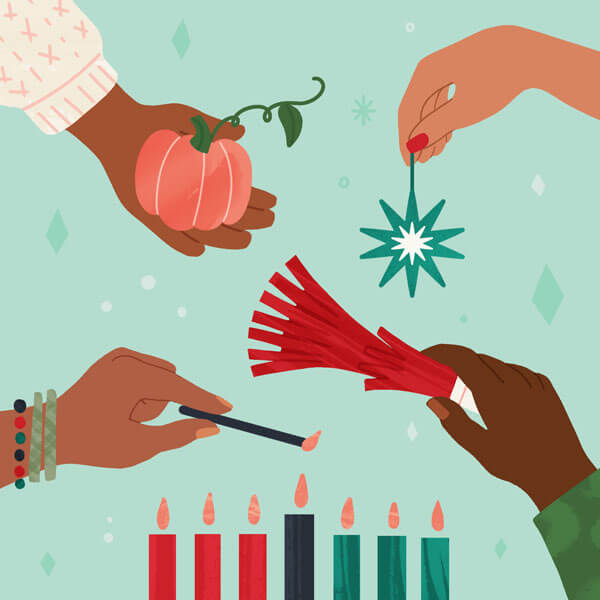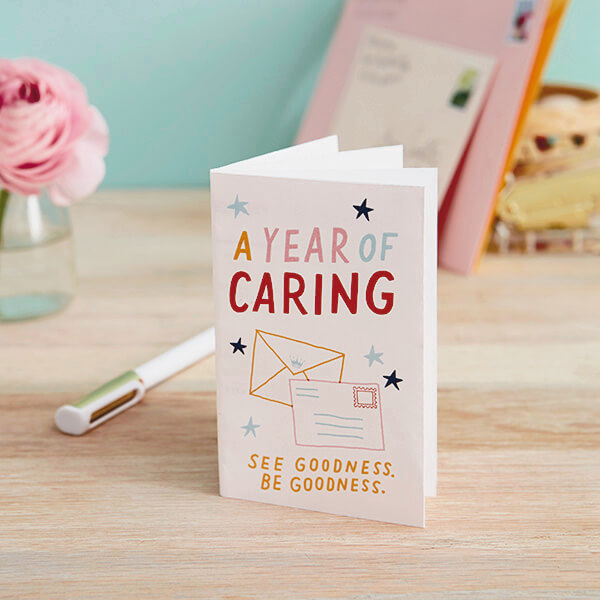What is Purim?

Purim, pronounced poor-im, is a joyous one-day Jewish festival that honors an event detailed in the biblical Book of Esther. It takes place in the springtime, on the 14th day of the Hebrew month of Adar, which usually occurs around March. The festival celebrates bravery, courage and the importance of doing the right thing—and is a jubilant affirmation of Jewish survival.
Inspired? Create and share by tagging @HallmarkStores.
The history of Purim
Purim commemorates the story of Queen Esther of the Persian Empire rising up against hate, honoring her Jewish heritage and protecting her people.
The story begins between the fourth and fifth centuries when King Ahasuerus of Persia chooses Esther to be his queen. Esther’s cousin, Mordecai, instructs her to keep her Jewish identity a secret as this information could endanger her life. In fact, the king’s prime minister and top advisor, Haman, is a power-hungry and wicked man who, Esther soon learns, is plotting a massacre to annihilate all the Jews in the kingdom.
When Mordecai gets wind of Haman’s evil plan, he immediately contacts Esther and they decide to work together to stop Haman. Mordecai encourages Esther to come forward and reveal her Jewish identity to the king in order to save their people.
Although approaching the king unannounced—or revealing her true identity—could be punishable by death, Esther takes the risk and tells the king the truth. She pleads with him to intervene in Haman’s plot to exterminate the Jews.
The king is outraged and puts a halt to Haman’s plan and sentences Haman to death. King Ahasuerus even names Mordecai his top advisor. Soon after, there is a battle against those who wished to aid Haman in destroying the Jews and the Jews emerge victorious.
Purim celebrates the courage and bravery it took for Queen Esther to come forward and how the good actions of a few can affect many.
Traditional Purim celebrations
Costumes and performances
Kids and adults alike don clever costumes and dress up as characters from the Purim story, including King Ahasuerus, Queen Esther, Mordecai or Haman. Masks and costumes—and masquerading in general—are used in part as a nod to Queen Esther’s early concealment of her Jewish identity.
Jewish communities also celebrate Purim with carnivals and parades and perform skits, songs and plays (Purim spiel) that reenact and pay tribute to the events that occurred so long ago. During these retellings of the Purim story, audience or congregation members use noisemakers called groggers to “blot out” wicked Haman’s name each time it is uttered.
Joyous feasts and symbolic foods
It’s customary to enjoy a fun feast with friends and family and to share Purim gift baskets (mishloach manot, “sending portions”) full of breads, sweets, fruits, nuts or wine with friends or neighbors.
Some of the most popular Purim treats are hamantaschen, which translates to “Haman pockets” in Yiddish. The structure is said to be a symbol of the hat Haman wore. Hamantaschen are triangular-shaped shortbread cookies with sweet or savory fillings in the center. Popular fillings include poppy seeds, fruit jams, prunes, apricots, chocolate, cherry…the options are endless (and delicious).
Meaningful Purim traditions
Charitable giving (matanot la’evyonim)
The Book of Esther calls on Jews to donate meals or money to those in need during Purim to build friendship and goodwill and ensure all who wish to celebrate Purim with a feast have enough to do so.
Retelling the story
Reading the Book of Esther (Megillat Ester) during synagogue services on the eve of Purim is considered a mitzvah, or a commandment and good deed.
The Fast of Esther
It is customary to fast the day before Purim from dawn to dusk to represent the fasting Esther did in the days prior to approaching the king. The fast is said to allow for soul-searching, which builds strength.
Purim greetings
- Chag Purim Sameach (KHAHG poor-im sah-MEY-akh), meaning “Happy Purim!”
- Chag Sameach (KHAHG sah-MEY-akh), meaning “Happy Holiday!”
You may also like
See more-
Christmas Sweet dreams, Santa!
Catch Santa napping on the job with this Snoring Santa Keepsake Ornament featuring sound and motion. With every snore...
-
Kwanzaa What is Kwanzaa?
What is Kwanzaa? A festival of lights rich in African symbolism, it takes place each year from December 26th through ...
-
Christmas Advent calendar activities for adventurous families
It’s time to start the countdown. Maybe it’s about being mindful…or counting your blessings…or preempting your kids a...
-
Summer Ways to celebrate Juneteenth
While Juneteenth was officially recognized as a federal holiday in 2021, this pivotal moment in history has been cele...
-
Christmas Christmas and Kwanzaa: Keeping family holiday traditions and finding your own
Whether you’re single or starting a family, religious or agnostic, someone who celebrates Christmas and Kwanzaa or ju...
-
Halloween Make ghosts and goblins feel right at home this Halloween
Light up your home with haunting Halloween seasonal decor. 🎃👻 Shop now at Hallmark Gold Crown stores or at Hallmark.com.
-
Halloween No scaredy cats around here!
When this black cat crosses your path, you know fun can't be far behind. 😻 🧙♀️ Shop the Zip-A-Long Cat in Hallmark G...
-
Halloween While you’re waiting for The Great Pumpkin this Halloween…
Fly around the pumpkin patch with Zip-a-long Snoopy! 🎃 Shop more frightening finds in Hallmark Gold Crown stores and ...
-
Halloween Light up the night with frightful fun!
Could it be? Could it be!? Yes it is! It’s the Peanuts® Snoopy and Woodstock Halloween figurine! 🎃 🐶 Find it and more...
-
Halloween Where cozy meets mischief and magic
Make some magic this Halloween with this Hocus Pocus hooded blanket. 🧙♀️👻Find more Halloween essentials in Hallmark ...
-
Gifting Relive a favorite from your childhood!
Fill your home with a few small joys inspired by Disney’s “It’s a Small World” 🩵🎎 Shop the collection at Hallmark Gol...
-
Halloween Which house will you be sorted into?
The Harry Potter™ Sorting Hat™ Mug plays sound whenever you lift the lid. Find this chatty mug in Hallmark Gold Crown...
-
Encouragement How to support caregivers
It’s often hard to know how to support a caregiver. Most caregiving checklists out there hit the major topics like me...
-
Love 50 different ways to say I love you
You don’t need to wait for a special occasion to remind that certain someone how much he or she is loved. Spice up yo...
-
Graduation 15 graduation quotes
Celebrate your favorite grad’s milestone with the wit and wisdom of Hallmark writers, fans and others. We’ve rounded ...
-
Congratulations How to congratulate someone
Congratulating others is easy and fun, right? Like when your friend worked really hard and got that awesome job makin...
-
Care & Concern Be more caring with a kindness journal
It's obvious the world could use more kindness. So this year, why not make "be more caring" your number one resolutio...
-
Fall Día de Muertos: A celebration of life and love
Día de Muertos, Day of the Dead, is a holiday originally celebrated in the southern and central parts of Mexico and i...
-
Card Ideas Card messages for kids: What to write in a kid’s holiday card and more
My 3-year-old was having a hard time at preschool drop-off. Dragging his feet. Asking to stay home. This went on a fe...
-
Christmas 6 Creative Christmas Card Display Ideas
Holiday card season is here: Our mailboxes are about to fill up with festive envelopes with pretty stamps and familia...





















